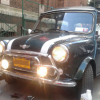As Ethel points out, the Hazard switch does "double-duty":
- First, when "OFF" it acts as a "transit path" for electrical current from the indicator flasher to the indicator switch on the stalk and
- Second, when "ON" it acts as a way to cut off that path and deliver current to ALL the indicator lamps at once from the Hazard Flasher
Take a look at the blue box in the upper left-hand corner of the diagram here:  wiring.png 376.78K
95 downloads
wiring.png 376.78K
95 downloads
#1 is the indicator flasher
#2 is the stalk left-right switch
#3 is the Hazard dash switch
#4 is the hazard flasher
Note the ganged switch that Ethel described so well (shaped like an H that has fallen on its side inside #3) - when off (up in the diagram) your indicators will work, when on (down), your hazards should flash.
I had a similar issue with my Hazards switch where I had to wiggle it into the "perfect" position to get them to work - my issue was not wiring, nor relay, nor fuse, but rather an intermittent dash switch.
Fortunately, the "black box" MkIII "delta" switches are super easy to recondition - I've done my hazard, headlight and rear fog light switches in the past three years (because I live in NYC and shipping from the UK costs as much as a switch). And mine's a '91 mainstream as well so you likely have the same hazard switch.
Here's how:
- Use a thin bladed screwdriver to pry the switch out of the dash panel into the cockpit of the Mini.
- Work it up-and-down and side-to-side and take your time so you don't scratch anything.
- Disconnect the switch (noting orientation and connector fit for plugging back in later).
- Be careful to look at how the flat metal springs fit into the case as they are what hold the switch in the dash and you need to fit them so they place an outward pressure.
- Use two thin blade screwdrivers at the same time to lift the tabs on each side simultaneously to "split" the switch box.
- Clean out the back of the switch box, removing any foreign material or dried grease on the contact points - or, as in the case of my headlight switch, remove the plastic that had melted over the contact point [the PO had wired driving lamps with no relays] and re-grease the flat contact area that slides up and down across the contacts with a good dielectric grease being careful not to put too much on it so it won't accidentally short contacts it should not and lubricate the pivot points with a non-drying grease.
- Pry the sides apart on the front of the switch just enough to allow the switch's plastic cylindrical pivot pins to slip free and the switch should "fall apart" out of the front.
- Note that there is a tiny little light in here that is connected to the tiny spade connectors - test it with a continuity tester now before you reassemble.
- Once everything looks good, reassemble in reverse order.
- Check switch pivot action.
- You should be good to go, but if you like you can check switch operation pin-to-pin outside of the car with a continuity tester (there is a good description of the expected operation of the electrics of this "double-duty" switch here) and Ethel's description is spot on as well.
- Pop it back in the dash and if the issue WAS just the switch, you'll have flashers again!
Now I know you've indicated that you've already purchased a new switch, but you still might want to take your old switch apart for a few reasons:
- you might get it working and then you'll have a spare
- you might want to simply salvage the little illumination bulb in it even if you don't keep the old switch - it just screws in and it's 80 pence at MiniSpares if the one in your new switch blows out
- or take it apart just to understand the innards
Good luck!




















